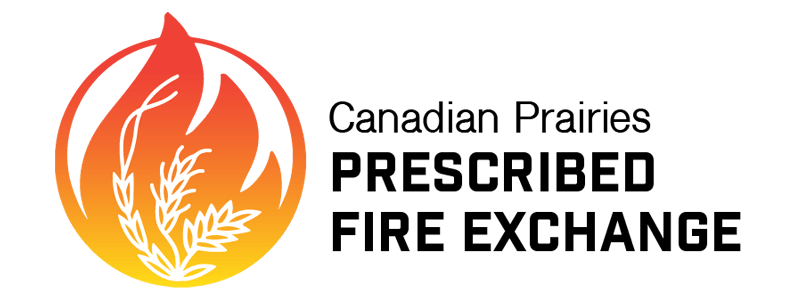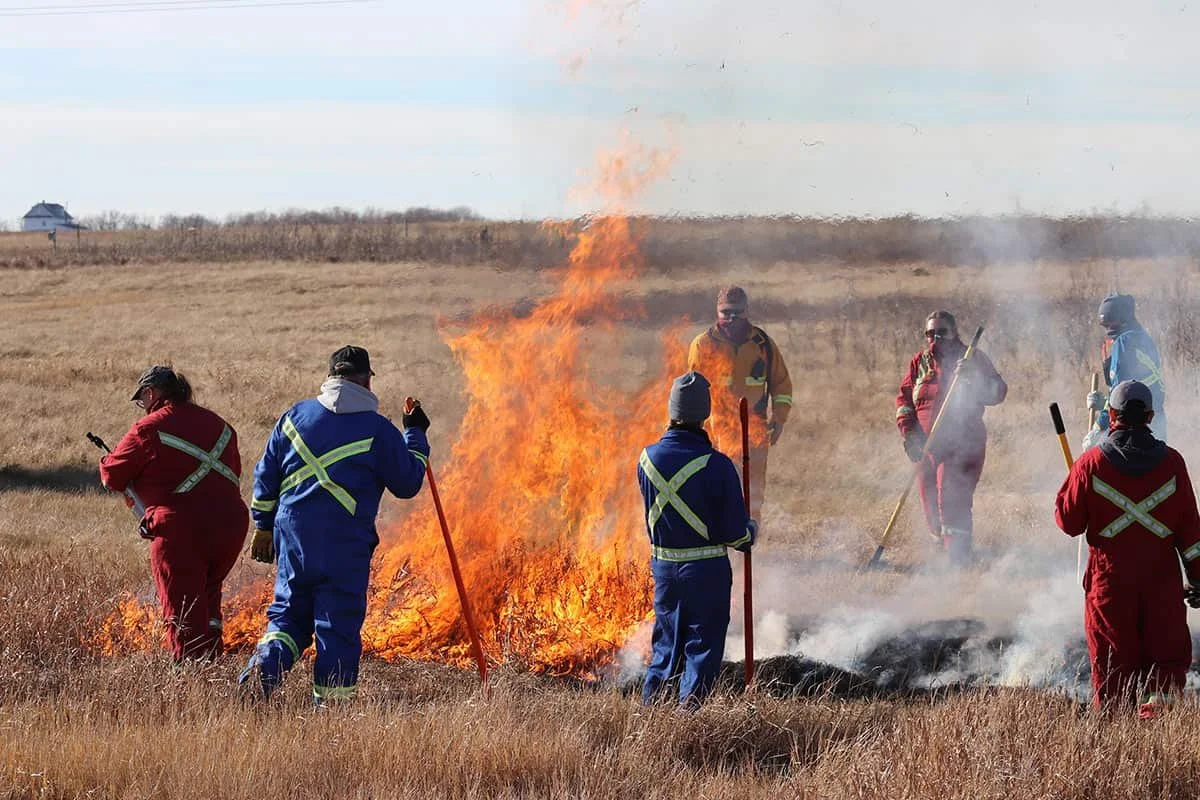Meewasin Valley Authority – November 2021 Prescribed Fire at the Northeast Swale
On November 4, 2021, Meewasin Valley Authority in Saskatoon, Saskatchewan conducted a 5 acre prescribed fire at the Northeast Swale. The Northeast Swale is a 300 hectare natural area within the City of Saskatoon that contains native grasslands, shrublands, aspen stands, and wetland complexes. Meewasin has been conducting prescribed fires at this site for over 15 years.
Planning for this prescribed fire burn unit has been ongoing for the last 5 years. The unit was grazed in 2018 by 300 sheep, targeting the growth of shrubs including Western Snowberry and Wolfwillow. A prescribed fire was planned for this unit in 2019, 2020 and spring 2021 however burn prescriptions were never met due to various factors including the severe drought in spring 2021 and the abnormal wind conditions in 2020 and 2021.
The burn unit was prepared in September 2021 with a double mow line fire guard prepared around the perimeter of the burn unit on the west, north and east flanks, with the south flanks being a mowed hiking trail. A prescribed fire plan was prepared in mid-September with a target to burn anytime between mid-September until winter conditions set in. In late August, a small rain finally hit the region, triggering greening up of native and invasive grasses due to the severe drought. These green-up conditions existed until late October, when killing frosts finally helped cure the grasses.
Objectives
The objectives of the prescribed fire were to remove thick litter layers, use fire to reduce the cover of wolfwillow and western snowberry, and use fire to “dry out” the site during the drought to reduce Kentucky bluegrass presence and improve conditions for native grass species that are more drought tolerant. Specific prescription conditions were 5 to 20C temperature, relative humidity of 30-50%, windspeed 5-15 km/hr, and winds from the south-west to the east to reduce smoke conditions impacting Saskatoon. Fuel conditions were fair to heavy on the site, with matting of Kentucky Bluegrass in several areas.
Click to view larger images
On the morning of the prescribed fire, Meewasin put out a call to various partners that a prescribed fire window has opened up and conditions were ideal to conduct this prescribed fire. Everyone met on site at 12 noon, because of the frost and dew from the previous night. There was a large contingent of volunteers with 6 Meewasin staff, including Dinyar Minocher with the Canadian Prairies Prescribed Fire Exchange, two people form the City of Saskatoon, one from Nature Conservancy of Saskatchewan – Saskatchewan Region, three from the University of Saskatchewan, Plant Sciences Department, one person from the RM of Three Lakes Fire Department, and one person from Tongue Creek Ranch in Alberta. Also in attendance was a volunteer and a Meewasin staff person taking pictures. On the fire line was a UTV and Rancher water unit from the City of Saskatoon and Meewasin’s “water truck”. Other equipment on the fire line was water packs, leaf blowers and flappers.
A test fire was started in the southwest corner of the burn unit at 12:30 PM, with relative humidity at 69%, air temperature at 6C, and wind at SE 4 km/hr. Forecast was for conditions to meet the prescription into the afternoon and the test fire was burning successfully, so the call was made to proceed with the prescribed fire. The City of Saskatoon Fire Department was notified that Meewasin was going to proceed with the fire, with a call to dispatch.
Blacklining
Blacklining started between the two mowed fire guards on the southwest flank and proceeded to the north, then from northwest to the northeast corner, then down the eastern flank to the southeast corner. The process was slow, lasting from 12:30 to 4:00; partially because for several people on the fire line this was their first or second prescribed fire. Several people on the holding team received the Canadian Prairies Prescribed Fire Exchange’s Introduction to Prescribed Fire in the Canadian Grassland Environment course, so the blacklining was used as training for “mini” prescribed fires.
Blacklining was complete at 4:00 PM, and the decision was made to proceed with the primary ignition. Weather conditions at that time were 53% relative humidity, 12C temperature, and winds had shifted back to SSE 7 km/hr. Primary ignition was initiated at 4:00 PM, with strip fires ignited in the northeast corner with the fire line along the blackline to the northwest corner. Strip burns were conducted back and forth with an ignition team of two. Holding teams were placed along the northeast and northwest corners, and along the west and east flanks, with a UTV and Rancher unit in the northeast corner and the “water truck” located in the southwest corner.
Ignition
At 4:10, a halt to ignition was ordered when a spot fire was noticed along the northern fire guard; with observation made from the northwest corner observation team. The UTV team and one ground crew member from the northeast corner were upon the spot fire within one minute and extinguished the spot fire, where only 2m2 was burned. Upon inspection after the fire operations complete, an ember may have ignited some thatch in the mowed fire guard and proceeded to burn into the unmanaged vegetation outside of the burn unit. At 4:15, primary ignition was ordered to continue with ignition complete at 4:30.
During the final ignition operations from 4:15 to 4:30, a large column of smoke was created that lifted smoke into the atmosphere at 100 to 150 meters. The smoke column was seen from numerous locations within and outside Saskatoon, including downtown Saskatoon. The local Saskatoon Fire Department hall was sent out to check on the conditions, arriving at 4:25 to the site. Discussions with the fire hall indicated that central dispatch with the Saskatoon Fire Department failed to notify the local hall about the prescribed fire operations.
At 4:30 PM, primary ignition was complete and leaving remaining burn out to be completed until 4:45, when the holding teams engaged in mop-up operations. Mop up operations included hand tools (flappers and fire rakes), leaf blowers, and water packs putting out along the fire guard (first step), within 30 meters of fire guard (second step), and then interior (fourth step). Final step was walking a grid pattern with the mop-up team walking parallel about 3 meters apart, checking and dealing with hotspots. Mop-up was determined to be complete at 5:30 PM. Two crew members stayed on site until 7:30 PM when it was determined the fire was out and dispatch was called that fire operations were complete. The next morning, a crew of three walked transects of the burn unit checking for any hotspots, none were found.
Success
The prescribed fire was deemed a success, meeting the various objectives of the prescribed fire from an ecological perspective but also as a training exercise for many holding team members. A post-fire debrief was held where items were discussed on how to improve future prescribed fires and what was learned from this fire. Monitoring will be conducted in 2022 and 2023 to measure the impacts of the fire on management objectives for the site.





